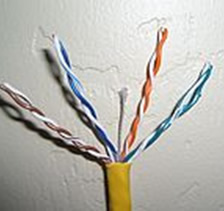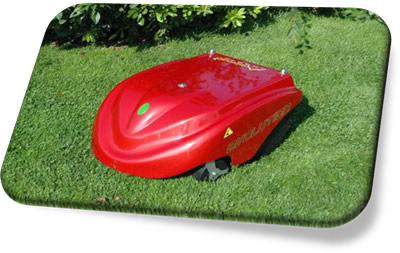
Home automation is the increased practice of full or partial automation of household appliances and features in residential dwellings, particularly through electronic means that allow for things impracticable, overly expensive or simply not possible in recent past decades. The simplest form of automation is a central heating timer, a thermostat or a PIR light in a driveway - but the realms of automation now far outreach these simple additions to standard wiring. The term may be used in contrast to the more mainstream "building automation," which refers to industrial settings and the automatic or semi-automatic control of lighting, climate doors and windows, and security and surveillance systems. The techniques employed in home automation include those in building automation as well as the control of home entertainment systems, houseplant watering, pet feeding, "scenes" for different events (such as dinners or parties), and the use of domestic robots.
Typically, it is easier to more fully outfit a house during construction due to the accessibility of the walls, outlets, and storage rooms, and the ability to make design changes specifically to accommodate certain technologies. Wireless systems are commonly installed when outfitting a pre-existing house, as they obviate the need to make major structural changes. These communicate via radio or infrared signals with a central controller.
The History of Home Wiring & Automation ...
Traditionally, homes have been wired for four things; power, telephones, TV outlets, and a doorbell. Typically today all controls, components, switchgear and wiring are kept within a cupboard, closet and/or dedicated patch panels placed within the fabric of the home, accessible - but out of site.

Home automation has been around since the early 1900’s, in fact, a television remote was patented in 1893. A remote was first used by the Germans in WWI to control motorboats, & from there, the evolution of controllers and automation has been growing and still continue to grow to this day.

Patch panel

CAT6 twisted pairs
Effects of Full Automation
In extreme installations, rooms can sense not only the presence of a person but know who that person is and perhaps set appropriate lighting, temperature and music/TV taking into account day of week, time of day, and other factors.
Other automated tasks may include setting the air conditioning to an energy saving setting when the house is unoccupied, and restoring the normal setting when an occupant is about to return. More sophisticated systems can maintain an inventory of products, recording their usage through an RFID tag, and prepare a shopping list or even automatically order replacements.
Some practical implementations of home automation are when an alarm detects a fire or smoke condition all the lighting in the house will blink to alert occupants. If the house is equipped with a home theater, a home automation system can shut down all audio and video components to alert the user to a possible fire or a burglar. CCTV monitors can be ‘presence-set’, so even if the screen is off it will come on if a person is detected within the camera range.
Choice of System

The elements of a domotics system are:
- hardware controllers or software controllers
- sensors
- actuator
Architecture
From the point of view of where the intelligence of the domotic system resides, there are three different architectures:
Centralized Architecture: a centralized controller receives information of multiple sensors and, once processed, generates the opportune orders for the actuators.
Distributed Architecture: all the intelligence of the system is distributed by all the modules that are sensors or actuators. Usually it is typical of the systems of wiring in bus.
Mixed Architecture: systems with decentralized architecture as far as which they have several small devices able to acquire and to process the information of multiple sensors and to transmit them to the rest of devices distributed by the house.
Hard Wired:
- optical fiber
- 2. cable (coaxial and twisted pair), including: xDSL
- 3.powerline, including: INSTEON X1
Wireless:
- radio frequency, including:
NSTEON
Wi-Fi
GPRS and UMTS
Bluetooth
Z-Wave
ONE-NET - infrared, including:
EnOcean
SCS BUS - OpenWebNet
- 3Data nets:
Ethernet
Homeplug
Wifi
HVAC

Heating, Ventilation and Air Conditioning (HVAC) solutions include temperature and humidity control, & HVAC, is one of the most important aspects to a homeowner and to his/ or her smart home in nearly every other country in Europe and the US – although not widely regarded as essential in the UK. Having a computer network installed at your home or business allows you to employ an Internet-controlled thermostat which can both save you money and help the environment, by allowing you to control the building's heating and air conditioning systems while the consumer is away.
Lighting
Lighting control systems involves aspects related to controlling electric lights.
- Extinguished general of all the lights of the house
- Automation of switched off / ignition in every point of light
- Regulation of the illumination according to the level of ambient luminosity
Natural lighting
Natural lighting control involves controlling window shades, LCD shades, draperies and awnings. Recent advances include use of RF technology to avoid wiring to switches and integration with third party home automation systems for centralized control.
Audio
Major companies associated with Audio Distribution include: Crestron, Russound, NuVo, and Niles.
- There are three components that allow the consumer to listen to audio throughout your home, or business:
- CAT 5e/ CAT6 cable from Audio central unit.
- 2 sets of speaker cabling (4ply from amplifier, and 2 ply from key pad to ceiling or wall speakers).
- A keypad to control your volume and sources.
This category includes audio switching and distribution. Audio switching determines the selection of an audio source. Audio distribution allows an audio source to be heard in one or more rooms. This feature is often referred to as 'multi-zone' audio.

CCTV & Video
This includes video switching and distribution, allowing a video source to be viewed on multiple TVs. This feature is often referred to as 'multi-zone' video.
Integration of the intercom to the telephone, or of the video door entry system to the television set, allowing the residents to view the door camera automatically.

Security
Control and integration of security systems.
With Home Automation, the consumer can select and watch cameras live from an Internet source to your home or business. Monitor a front door or gate; watch people by a swimming pool; or check on someone in a room. You can control security cameras and watch what's going on around a house or business right from a Monitor or touch panel.[4]. Security systems include motion sensors that will detect any kind of unauthorized movement and notify you through the security system or via cell phone.
This category also includes control and distribution of security cameras (see surveillance).
Detection of possible intrusion
Simulation of presence.- sensors of detection of movement
- sensors of magnetic contact of door/window
- sensors of glass breaking
- sensors of pressure changes
- Detection of fire, gas leaks, water leaks (see fire alarm and gas alarm)
- Medical alert. Teleassistance.
- Precise and safe closing of blinds.
Intercoms
An intercom system allows communication via a microphone and loud speaker between multiple rooms.
- Ubiquity in the external control as much internal, remote control from the Internet, PC, wireless controls (p.ej. PDA with WiFi), electrical equipment.
- Transmission of alarms.
- Intercommunications.
Robotics
- Control of home robots, using if necessary domotic electric beacon.
- Home robot communication (i.e. using WiFi) with the domotic network and other home robots.

Costs
An automated home can be a very simple grouping of controls, or it can be an automation extravaganza where just about anything that is plugged into electrical power is remotely controlled. While there is no way to know what the consumer wants, their only limit to a smart home is his or her budget. Costs mainly include; equipment, components, furniture, and custom installation.
Other systems
Using special hardware, almost any device can be monitored and controlled automatically or remotely.
Including:
- Garage door(s)
- Pet feeding and watering
- Plant watering
- Pool pump(s) and heater, Hot tub and Spa
- Sump Pump

Some good UK based Home Automation Links to obtain further information & compare costs:
www.cyberhomesltd.co.uk
www.installautomation.net
www.automatedhome.co.uk
www.uk-automation.co.uk
www.brilliantliving.co.uk
www.myhome247.co.uk

